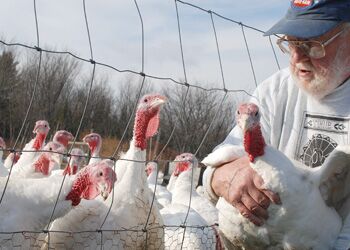King of the range | Thanksgiving arrives at Maine's largest turkey farm
 Photo/Bobbie Hanstein
Bob Neal hopes his healthy, free-range turkeys flocked to Thanksgiving tables across Maine
Photo/Bobbie Hanstein
Bob Neal hopes his healthy, free-range turkeys flocked to Thanksgiving tables across Maine
Bob Neal has a fiscal barometer this time of year like no other. Just call it drumstick economics. And like so many of the more conventional indicators, news is mixed.
Orders are down — yet size is up.
Neal and his wife, Marilyn, own The Turkey Farm, Maine’s largest by number of birds in New Sharon where they’ll raise 3,200 free-range turkeys by year’s end. Half are slated to star in Thanksgiving dinner.
In all but one of the farm’s 24 years, Neal has sold out of Thanksgiving turkeys, which makes odds good for this year, but Neal says orders are coming in slower. At the start of the third week of November, he’d sold 84% of the 1,600 birds bound for market.
“It’s been a roller coaster,” Neal says. One day, 40 orders. The next, seven.
The trend that holds the most financial promise: Most early retail orders were for 20- to 22-pound birds; 16- to 18-pounders led the pack last year.
At $2.95 a pound for his turkeys, Neal says he isn’t out to compete on price with Hannaford, Shaw’s or Wal-Mart. Chains take a loss on each turkey they sell this time of year, in the range of 50 cents or more a pound, he says. The big retailers anticipate they’ll make that up when customers fill grocery carts with biscuits, cranberries and other staples.
“I tell people I’m selling taste — and I happen to give them a more healthful bird at the same time,” says Neal.
The Turkey Farm starts with a slow-growing breed of bird out of Massachusetts. As soon as chicks have feathers to stay warm, they’re let loose to live on one of seven outdoor ranges. They get a tiny bit of their diet from scratching and picking at the ground; the rest comes from a steady offering of feed with soy, corn, alfalfa, wheat and barley, and treats like raw pumpkin from a farmer up the road.
By contrast, he says, many commercial brands sold in stores use a fast-growing breed of bird, raise them in barns — they don’t walk off as many calories — and feed them by flicking the lights on every few hours for 15 to 20 minutes. (Turkeys don’t eat in the dark.)
Neal’s Thanksgiving birds were born in May, June and July; staggering them allows for a variety of weights come fall, he says.
“Our first couple years we did 68% of our year’s gross at Thanksgiving,” he says.
Now, the farm is more diversified. That one holiday accounts for 32% of gross. Twelve-hundred birds go into products like breast roast and sausage links. In this economy, ground turkey sales have held steady, Neal says, while steaks and tenderloin sales are down.
He keeps an open exchange with customers on the farm’s website and newsletter, The Turkey Times, sharing details like when feed prices go up or down, and by how much.
“I don’t like the cliché food with a face... but it makes a much more personal relationship,” Neal says.
The Turkey Farm has pulled back its wholesale locations, going from having products in 29 stores at once to just seven stores and two kitchens. Neal cites increased competition and transportation costs. Due to federal regulations, he only sells in Maine.
After the Thanksgiving rush, he’ll dress 100 to 200 birds for Christmas. The farm will spend from the end of December to mid-February bird-free. “The industry term is depopulated — the term that I use is, ‘We killed them all,’” Neal says.
That break is healthy for the farm, Neal and Marilyn. His original plan was to retire next year, at 70.
“I have an awful hard time even smiling a little bit when someone says, ‘It’s time to talk turkey.’”









Comments